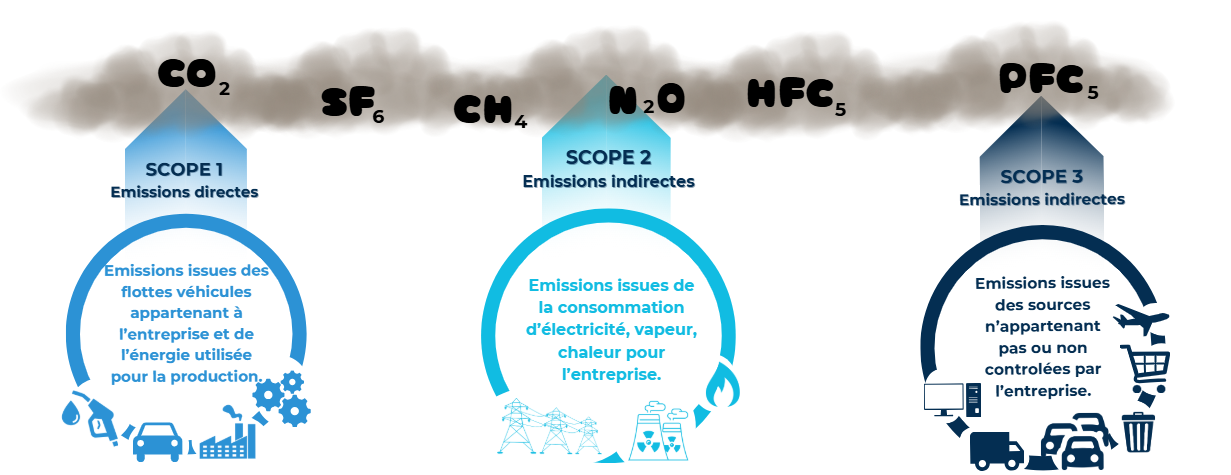Carbon plan: how to structure your reduction targets and actions?

Reducing GHG (greenhouse gas) emissions is essential to meeting stakeholder expectations, improving competitiveness and anticipating market trends. But how do you structure an effective carbon strategy? What actions can you take to optimize your energy balance and contribute to a sustainable climate transition?
In this article, we'll look at the reasons for establishing a low-carbon approach, the steps to follow, and how GCI supports companies with a proven methodology and tailored tools. We will also explore a concrete project enabling organizations to achieve their emissions reduction goals.
1.1 Regulatory context and international commitments
1.2 Benefits for the company (competitiveness, image, compliance)
2. Key stages in building an effective emissions reduction program
2.1 Identifying sources of emissions (Scopes 1, 2, 3) / Drawing up a GHG balance sheet
2.2 Raising awareness and mobilizing your team
2.3 Defining concrete ambitions and action plans
2.4 Define a carbon trajectory (performance monitoring and reporting)
3. How does Global Climate Initiatives (GCI) support companies in their carbon reduction plans?
Why draw up a carbon plan?
📜 Regulatory context and international commitments
Companies are increasingly faced with regulatory obligations to reduce their greenhouse gas (GHG) emissions. In France, the Grenelle II law requires structures with more than 500 employees in mainland France to carry out a Bilan Carbone® every four years. What's more, the European CSRD (Corporate Sustainability Reporting Directive) requires structures with more than 250 employees to publish a non-financial report by January 2025.
At international level, the Paris Agreement, adopted in 2015, aims to limit global warming to less than 2°C by 2100, which implies a reduction in GHG emissions of at least 50% by 2030.
💼 Benefits for the company (competitiveness, image, compliance)
Developing a low-carbon strategy has several advantages for companies:
- Boosting competitiveness: Decarbonization helps to optimize processes and reduce operating costs, especially energy-related costs. Action on energy efficiency can generate potential savings of 10 to 25% on energy bills(source).
- Regulatory compliance: Complying with legal obligations, such as carrying out a Bilan Carbone®, avoids financial penalties of up to €50,000, or even €100,000 in the event of a repeat offence(source).
- Access to financing and subsidies: Financial institutions favor companies committed to sustainable practices, facilitating access to green financing, public subsidies and tax incentives.
- Attractiveness for talent: Employees are often proud to work for a responsible company committed to environmental protection, which can improve employee loyalty and satisfaction.
- Improved brand image: Consumers are increasingly sensitive to environmental issues. A company committed to reducing its carbon footprint strengthens its credibility and attracts environmentally conscious customers(source).
In short, developing a decarbonization approach is not only a response to regulatory and international requirements, but also a strategic opportunity for companies to improve their overall performance, image and competitiveness in the marketplace.
The 7 advantages of carrying out your company's GHG assessment.
Key stages in building an effective emissions reduction program
🔍 Identifying sources of emissions (Scopes 1, 2, 3) / Drawing up a GHG balance sheet
The first step in developing effective decarbonization initiatives is to carry out a GHG assessment to identify the company's sources of greenhouse gas (GHG) emissions. These emissions are classified into three categories:
- Scope 1: These are direct emissions produced by the company, such as fuel combustion in company vehicles or emissions linked to industrial processes.
- Scope 2: This scope covers indirect energy-related emissions, notably those resulting from the production of electricity, heat or steam purchased and consumed by the company.
- Scope 3: This covers other indirect emissions, such as those associated with the supply chain, business travel, the use of products sold and waste management.
To carry out this assessment, we recommend following the Bilan Carbone® method developed by ADEME, which provides a structured approach to quantifying GHG emissions.

🎯 Raising awareness and mobilizing your team
The success of a low-carbon strategy depends on the involvement of all employees. It is essential to make them aware of climate issues and inform them about the company's carbon footprint. Actions such as training workshopsworkshops seminars or internal communication campaigns can be set up to mobilize teams.
📊 Define concrete ambitions and action plan
Once the sources of emissions have been identified and the teams mobilized, it is crucial to define clear and ambitious reduction targets. These commitments must be aligned with international commitments, such as the Paris Agreement, and adapted to the company's specific context. For example, a company might aim to reduce its emissions by 50% by 2030(source).
To achieve these targets, a detailed strategy must be drawn up, including specific measures such as :
⚡ Improving energy efficiency: optimizing processes to consume less energy.
🌞 Transition to renewable energy sources: adopting clean energies to reduce carbon footprint.
🔄 S upply chainoptimization : selecting suppliers committed to sustainable practices.
🚲 Promoting sustainable mobility: encouraging the use of environmentally-friendly modes of transport for business travel.
It is important that this approach is integrated into the company's overall strategy, and that it enjoys the support of top management.
📈 Define a carbon trajectory (performance monitoring and reporting)
Once the strategy is in place, it is essential to regularly monitor performance to ensure that the commitments for a reduction are met. This involves setting up a reporting system to measure progress and identify areas for improvement. For example, some companies are adopting low-carbon trajectories aligned with the recommendations of the Science Based Targets initiative (SBTi).(source)
This monitoring must be transparent and communicated to stakeholders, notably via annual reports or dedicated publications, in order to demonstrate the company's commitment to the climate transition.
In conclusion, developing an effective low-carbon strategy requires a structured approach, from the identification of emission sources to the definition of ambitious targets and the implementation of rigorous monitoring. This approach enables the company to make an active contribution to the fight against climate change, while strengthening its competitiveness and image.
How does Global Climate Initiatives (GCI) support companies in their carbon reduction plans?
Global Climate Initiatives (GCI) offers a comprehensive range of services to help organizations develop and implement effective strategies to reduce their greenhouse gas (GHG) emissions.
🛠️ Tools and methodologies
GCI provides modular, customizable solutions that facilitate the production of GHG assessments in line with international standards. These include questionnaires adapted to different business sectors and company sizes, guaranteeing accurate and relevant data collection. The platform is designed to be user-friendly, enabling even novices to quickly get to grips with its functionalities thanks to two-hour video training sessions. What's more, it offers multi-user compatibility, encouraging collaborative working within teams.
📌 Case studies and testimonials
Many companies have benefited from GCI's expertise in their transition to a low-carbon economy. These include Amaury Sport Organisation (A.S.O) worked with GCI to assess the carbon footprint of its events, demonstrating its commitment to sustainability. Similarly, the Schmidt Group succeeded in involving 80% of its suppliers in its drive to reduce emissions, illustrating the effectiveness of the solutions offered by GCI.

Schmidt Group
Christophe CHRISTEN
Purchasing Methods Manager
The Schmidt Group is France's leading manufacturer of made-to-measure kitchens, storage units and bathrooms.
To give concrete expression to its commitments, the group has chosen an innovative partner, specialized in decarbonizing Purchasing, with a collaborative solution: GCI.

French Badminton Federation
Benjamin GRIZBEC
Bad & Handicap / Eco-responsibility Project Manager
The French Badminton Federation (FFBaD) has chosen GCI to assess the carbon footprint of its activities, as part of its commitment to social performance.
This dynamic partnership continues with the GHG inventory of 20 affiliated clubs, marking a significant step in the transition to a sustainable approach within the federation.
🌱 In addition: carbon offsetting/contribution
In addition to reducing emissions, GCI helps companies to offset their carbon footprint. This includes certified projects that enable organizations to offset their residual emissions by investing in ecological initiatives, thus contributing to carbon neutrality.
In short, GCI offers complete support to structures, from the precise assessment of emissions to the implementation of reduction and offsetting strategies, strengthening their competitiveness while meeting regulatory requirements and societal expectations.
Implementing a low-carbon strategy is now a necessity for all companies wishing to take part in the climate transition process and meet the regulatory, economic and environmental challenges.
Thanks to a structured approach - from the identification of greenhouse gas (GHG) emissions to the implementation of a clear and measurable process - it is possible to significantly reduce one's carbon footprint while improving one's competitiveness and brand image.
Global Climate Initiatives (GCI ) provides customized tools and support to help organizations structure their low-carbon strategy and achieve their reduction targets. From carrying out a GHG assessment to carbon offsetting actions, GCI enables an organization to move effectively towards carbon neutrality and anticipate future regulations, notably in conjunction withADEME, DPEF and ISO standards.
Committing today to a national low-carbon strategy is an opportunity for all structures in France and Europe. It's time to act for a more sustainable future!
Our carbon experts will be happy to give you a free free demonstration of our platform. 🚀
Sources
- https://www.cci.fr/ressources/developpement-durable/la-decarbonation-levier-de-performance-et-de-competitivite
- https://climate.selectra.com/fr/entreprises/bilan-carbone
- https://www.lyon-metropole.cci.fr/notre-blog/bilan-carbone-9-avantages-pour-votre-entreprise
- https://www.agenda-2030.fr/17-objectifs-de-developpement-durable/article/odd13-prendre-d-urgence-des-mesures-pour-lutter-contre-les-changements?#:~:text=Concr%C3%A8tement%2C%20l objective%20of%20the%20neutrality%C3%A9%20carbon%20by%202050.
- https://www.bl-evolution.com/comment-mettre-en-place-une-trajectoire-de-reduction-compatible-avec-les-objectifs-du-sbti/







